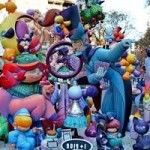Spain is known the world over for its fiestas – that is, its feast days or celebrations. One of the most spectacular of these is  Las Fallas, which is celebrated in Valencia and means ‘the fires’ in the local dialect. Originally a celebration in honour of the feast day of St. Joseph, Las Fallas has today evolved into a 5-day event to which up to two million people flock from all over Spain and indeed the world.
Las Fallas, which is celebrated in Valencia and means ‘the fires’ in the local dialect. Originally a celebration in honour of the feast day of St. Joseph, Las Fallas has today evolved into a 5-day event to which up to two million people flock from all over Spain and indeed the world.
The festival centres on the ninots (‘puppets’ or ‘dolls’) which are effigies, often bawdy or satirical, many of which are so large they need to be hoisted into place by cranes, and which locals often spend a great part of the year, and a great deal of money, making. The ninots are placed at over 350 crossroads and parks around the city on the day known as La Plantà (the rising), and remain there until 19 March which is called La Cremá (the burning). On that day, the ninots are stuffed with fireworks and, with the streetlights turned off and to the chants of the gathered crowds, they are set alight at midnight. One of the figures, however, is chosen by a vote to be spared from the fire; this is known as the ninot indultat (the pardoned puppet) and it will take its place in the local museum alongside its fellows from previous years.
When attending Las Fallas, it is advisable to familiarise yourself with the locations of the various celebrations around the city. A Spanish language course will really stand you in good stead, supplying the vocabulary to ask for directions and to understand the signs you might see along the streets.